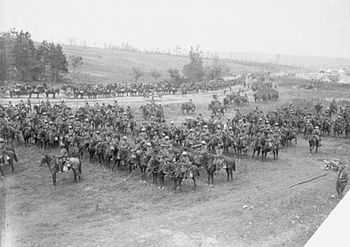9th (Secunderabad) Cavalry Brigade
| 9th (Secunderabad) Cavalry Brigade | |
|---|---|
|
Units of the brigade at Bazentin Ridge France 1916 | |
| Active | 1907–1940 |
| Country | British India |
| Allegiance | British Crown |
| Branch | British Indian Army |
| Type | cavalry |
| Size | brigade |
| Part of |
9th (Secunderabad) Division 1st Indian Cavalry Division 2nd Indian Cavalry Division |
| Engagements | First World War |
| Commanders | |
| Notable commanders |
Michael Rimington Charles Levinge Gregory |
The 9th (Secunderabad) Cavalry Brigade was a brigade of the British Indian Army formed in 1903, following the reforms of the Indian Army by the then Commander-in-Chief, India General Herbert Kitchener. It retained this title until 1929 when it was renamed 4th (Secunderabad) Cavalry Brigade. It was disbanded in July 1940.
History
The brigade was originally the cavalry formation of the 9th (Secunderabad) Division, but in 1914 it was sent to the Western Front in France as part of the 1st Indian Cavalry Division landing at Marseilles 13 October 1914. Later the brigade was transferred to the 2nd Indian Cavalry Division. Following the standard practise at the time, the brigade was formed with one British and two Indian cavalry regiments and a British artillery battery.[1][2][3]
Among the brigades engagement were the First Battle of Ypres, the Battle of La Bassée, the Battle of Armentières, the Battle of Neuve Chapelle, the Battle of Festubert, the Battle of the Somme, the Battle of Bazentin Ridge, the Battle of Flers–Courcelette and the Battle of Cambrai.[4]
Formation
- Commanders
- Brigadier-General Michael Rimington: September 1907 – May 1911
- Brigadier-General Edmund B. Burton May 1911 – July 1912
- Brigadier-General Richard Wapshare: July 1912 – January 1913
- Major-General Fredrick William George Wadeson: January 1913 – May 1916
- Brigadier-General Charles Levinge Gregory: May 1916 – March 1918
- Brigadier-General Howard Kennedy: February 1915
- Brigadier-General Francis Henry Bagot Commeline: April 1915 – April 1920
- Brigadier-General Aubrey G. Pritchard: April 1920 – January 1921
- Brigadier-General Charles Godwin: January 1921–1923
- Brigadier-General Guy Beatty: ?-October 1925
- Brigadier-General Edward D. Giles: October 1925 – December 1927
- Brigadier Alan Campbell Ross: December 1927 – January 1932
- Brigadier Alan F. Hartley: January 1932 – September 1933
- Brigadier Donald K. McLeod: September 1933 – December 1934
- Brigadier George de la P. Beresford: December 1934 – September 1938
- Brigadier Mosley Mayne: September 1938–1940[5]
- Pre war
- 7th (Princess Royal's) Dragoon Guards
- 7th (Queen's Own) Hussars
- 20th Deccan Horse
- 26th King George’s Own Light Cavalry
- 34th Prince Albert Victor's Own Poona Horse[6]
- Western Front
- 7th (Princess Royal's) Dragoon Guards
- 20th Deccan Horse
- 34th Prince Albert Victor's Own Poona Horse
- N Battery, Royal Horse Artillery
- 9th Indian Machine Gun Squadron
- Signal Troop Royal Engineers
- September 1939
- 14/20th King's Hussars [until November 1939]
- 7th Light Cavalry
- Prince Albert Victor's Own Cavalry [11th Frontier Force] [until October 1939]
- 4th Cavalry Brigade Signal Troop
- 3rd Field Regiment, RA (18th, 62nd, 65th, 75th Batteries)
Notes
- ↑ Rinaldi, p.330
- ↑ Griffith, p.166
- ↑ "Dragoon Guards 1914–1918". The Long Long Trail. Retrieved 19 September 2012.
- ↑ "History of the 17th Horse". Bharat Rakshak. Retrieved 19 September 2012.
- ↑ "Army Commands 1900–2011". Gulabin. Retrieved 19 September 2012.
- ↑ Rinaldi, pp.330–331
References
- Kempton, Chris Loyalty and Honour Part 2 - Brigades
